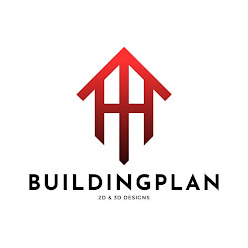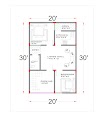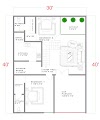In this article, We are going to discuss about very frequent and important terms which are used in the construction field. The following top 10 terms are listed below.
| TABLE OF CONTENT |
|---|
| SUB-STRUCTURE |
| SUPER-STRUCTURE |
| COLUMN |
| COLUMN-MATT |
| R.C.C AND P.C.C |
| EXCAVATION AND BACKFILLING |
| PLINTH BEAM |
| FORM WORK |
| CONCEALED BEAM |
| DEPTH BEAM |
1-Sub-structure
Sub-structure is also known as "foundation of the building". In the general term It is the part of the building which is constructed below the ground level is known as sub-structure or foundation. The sub-structure will be invisible once the foundation work is completed and backfilling is done. Sub-structure section is only used to transfer the entire building load to the soil or base through the columns which is known as "frame structure" In the sub-structure the following work will be done.
- Excavation work
- P.C.C Work
- Column Work with the column matt
- Formwork for concreting
- Backfilling
2-Super-Structure
Super-Structure is the part of the building which is constructed above the ground level. Super-structure is used for the accommodation purpose not for the load transforming The super-structure will be visible to the eye. In the super-structure the following work will be done.
- Plinth Beam Work
- Column Rising Work
- Wall Building work [brick or block]
- Lintel Beam Work
- Moulding or slab Work
- Parapet wall-work
- Drainage Work
3-Column
Column is the most important term in the construction world. Column is the structural member which is used to transfer the entire load of the building [Dead Load, Live Load, Wind Load, Earthquake Load, Seismic Load and other types of load] To the soil. Column type of construction is known as frame structure construction. Below image is a structural column drawing.
as you can see in the image first the P.C.C is laid for 3 inches then column matt is placed over which the column is tied and concrete is poured for 1'6" and the Column ties of 8mm diameter rod at 6 inch center to center spacing is used. The ties should be provide at 135 degree angle not at the 90 degree. The covering should be provided of at-least 1 inches on the both sides of the column rods in order to protect the steel rods for the corrosion and for providing the maximum strength.
4-Column Matt
Column Matt is a Matt which is laid above the P.C.C in which column is tied with the matt for uniformly distributed load [UDL] to the soil. The Below image is a structural column-matt drawing.
5-Difference Between R.C.C and P.C.C
R.C.C-Reinforced Steel Cement Concrete where P.C.C means -Plain Cement Concrete, in P.C.C no steel bars are used P.C.C is provided the avoid the concrete segregation in order to avoid Imperfect packing of concrete, Poor compaction and also Honey-combing of the concrete where R.C.C is used for the structural Purpose for providing the stability to the structure and to the building by transforming the load to the soil.
6-Excavation and Backfilling
Excavation is defined as the soil removing work from the base ground for Multiple Purposes Like for Underground water-tank construction ,Septic tank construction, Column Work, in which the column is going to place. Excavation area is first marked as per the requirement or the position of the tank and column. This work can be done by using Man-power and Machine-work [JCB] depend upon the area, size and usage.
Backfilling is Re-filling of the soil in the same excavated area mostly this is done where the columns are placed after concreting work the remaining area are backfilled with the same excavated soil.
7-Plinth Beam
Plinth Beam is defined as the structural beam which is placed in-between of the soil and the brick or block work which is going to built as per the plan. Plinth beam also provide the stability to all the column by connecting each of them It act as a solid frame which can resists the Earthquake. The covering should be provided for at-least 1 inches of spacing from the steel rods on the both sides of the beam. Even Covering should be provided at the base of the rod for plinth beam by placing the cover blocks in order to protect the steel rods for the corrosion and for providing the maximum strength.
The above represents a structural beam in which top and bottom rods are marked and shown the stirrups for the beam is provided at 6 inch center to center spacing. The stirrups should be provided at angle of 135 degree not at the angle of 90 degree.
8-Formwork
Formwork is also known as Centering or shuttering work which is provided to Hold the concrete till it gets hardened or attained a designed strength from the fresh concrete stage. It is a mold in which the concrete is poured to get the designed shape and the size. Formwork can be temporary or permanent. There are two types of formwork 1-Shuttering 2-Centering
1-shuttering-When the formwork is provided in the vertical direction like for column concreting, architectural wall building purpose etc.
2-Centering-When the formwork is provided in the horizontal direction Like for Moulding or slab concreting.
Formwork can be made by using:
- Wood or Timber
- Plastic
- Aluminum
- Fabric
- Steel
9-Concealed Beam
Concealed Beam is a horizontal Structural Beam which is also known as hidden beam or moulding slab. Concealed beam is provided during the slab concreting work .it is provided in the place in which the wall is going to build above the beam in order to Transfer the load directly to the base through column and to minimize the load in the slab.
10-Depth Beam
Depth Beam is a very important structural beam which is provided when the distance between the columns are more and when the load acting on the upper slab is more than normal load acting the normal slab. It can be used mostly in the commercial places like in the shopping mall, Big convection halls, Mosque, Parking Spaces, Cinema Hall and other places where in-between column are disturbance. In order to avoid the disturbance the columns are more spaced and depth beam is used.







